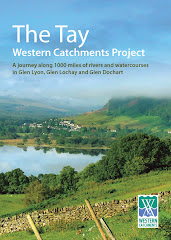ASPEN IN THE TAY WESTERN CATCHMENTS AREA
Summary
An important part of our TWCP survey work involved gathering information on native woodland, and native woodland fragments, and we kept a particular record of rare or minority forest species. One such species was our native aspen.
During the survey, 125 records were obtained in total. Of these, 59 were in Glenlyon, 12 in Glen Lochay and 44 on the Dochart.
120 of these records are new additions to the national database, with 4 records from Glenlyon and one on the Dochart already included. One record from the database, in Glen Lochay, was not located during our survey work.
For each stand, the numbers of trees of different age classes were recorded, and the location recorded by GPS.
Limitations of data
The importance we placed on locating and recording aspen increased in the 2008 survey season, to tie in with an increased interest in the species among many other organizations throughout the country, and the information gathered about each record became more specific, noting the numbers of trees of different age classes present. In the 2007 survey of Glen Lochay and part of the Dochart, aspen was given no greater prominence than other minor tree species. We therefore anticipate that a number of aspen stands will have been missed in 2007 in these areas. It should also be noted that aspen also grows as a non-riparian tree, and that there will be stands in this area not recorded simply because we were only surveying along watercourses. However, anecdotal evidence would suggest that aspen remnants that are removed from watercourses are very much more restricted than on Speyside, for example.
Two of the broadleaved woodland SSSI sites in this area, Glenlyon Woods and Glenlochay Woods, have aspen listed as a significant minor species in their documentation, although our survey transects did not record any. There are several other extensive areas of broadleaved woodland in this area where we did not have any survey transects that are likely to include aspen, such as the woods behind Fortingall at the bottom end of Glenlyon and the extensive woods at Innishewan on the Dochart system.
Finally, safety considerations often meant that we had to avoid very steep and dangerous gorges, many of which contained broadleaved woodland remnants. It is anticipated that we will have missed some aspen remnants in these situations.
Use for the Information Gathered
At present, it is extremely difficult to source planting material of native Scottish origin for aspen. There are currently being new procedures devised that will quickly increase the efficiency of both vegetative and seeding propagation of aspen, and a number of root samples will be collected from these records to build up the stock of suitable material that is available for planting out in both Highland Perthshire and the Loch Lomond and Trossachs National Park area. Given it’s light foliage and the high biodiversity of insect life associated with the species, aspen is an extremely valuable riparian species that does not have the shading and acidification issues associated with alders and conifers, for example, or non-native broadleaves such as beech or sycamore. Focusing on this species allows us to look more closely at the existing species mix in riparian woodlands, and how they might best be managed to provide a more balanced interaction with the water environment. Scottish Native Woods can provide a co-ordinating role on Tayside in all matters relating to the management and promotion of this species.
Accessing the Information
The information gathered on aspen will be added to the National database which will be made more accessible during 2009 through an inter-active mapping facility. Maps for each of the three glens can be obtained from Scottish Native Woods. Information on the inter-active website will be forwarded as this is progressed.
You can see the finer details on any of these maps by clicking on the image.
Wednesday, 25 February 2009
Subscribe to:
Post Comments (Atom)


No comments:
Post a Comment